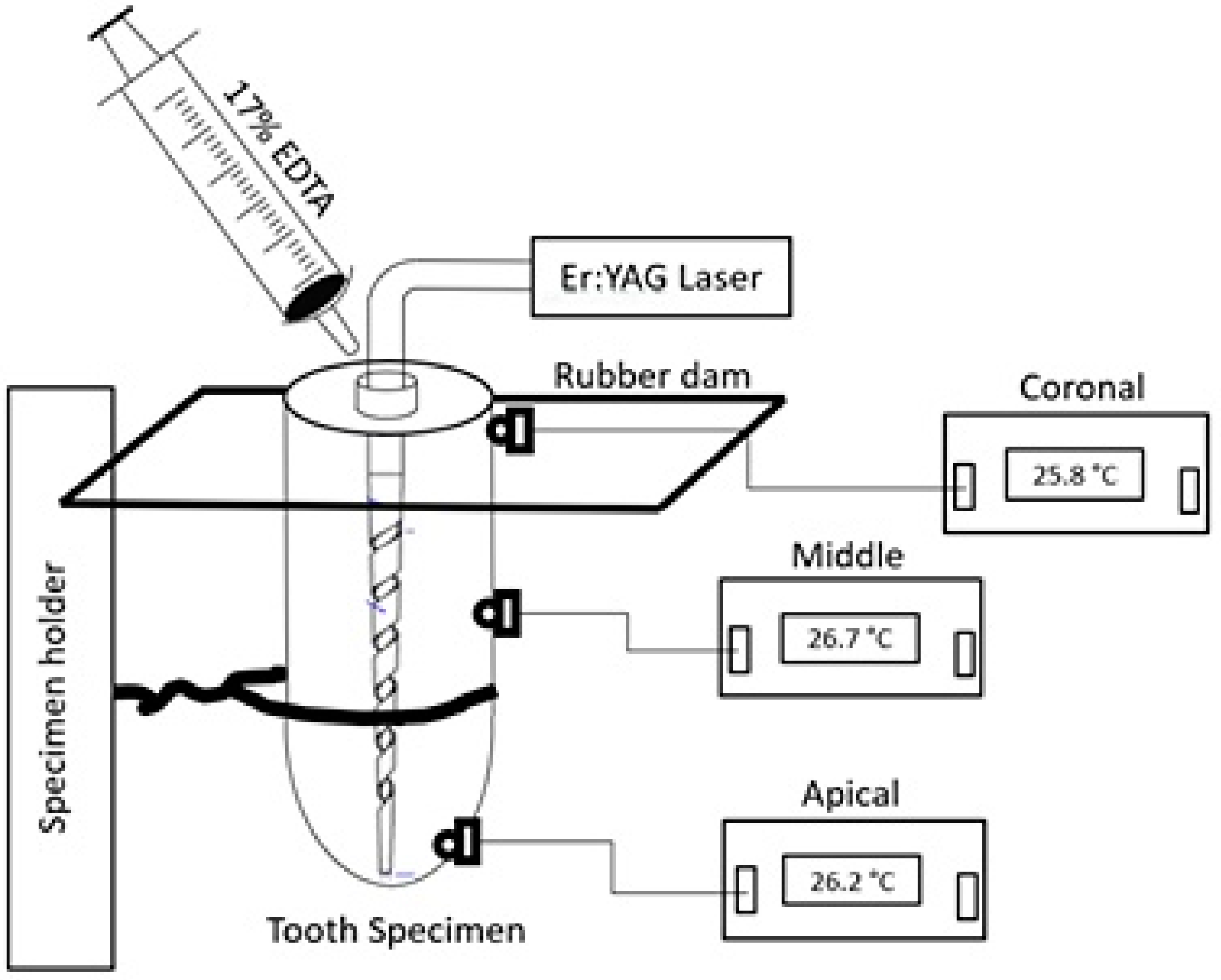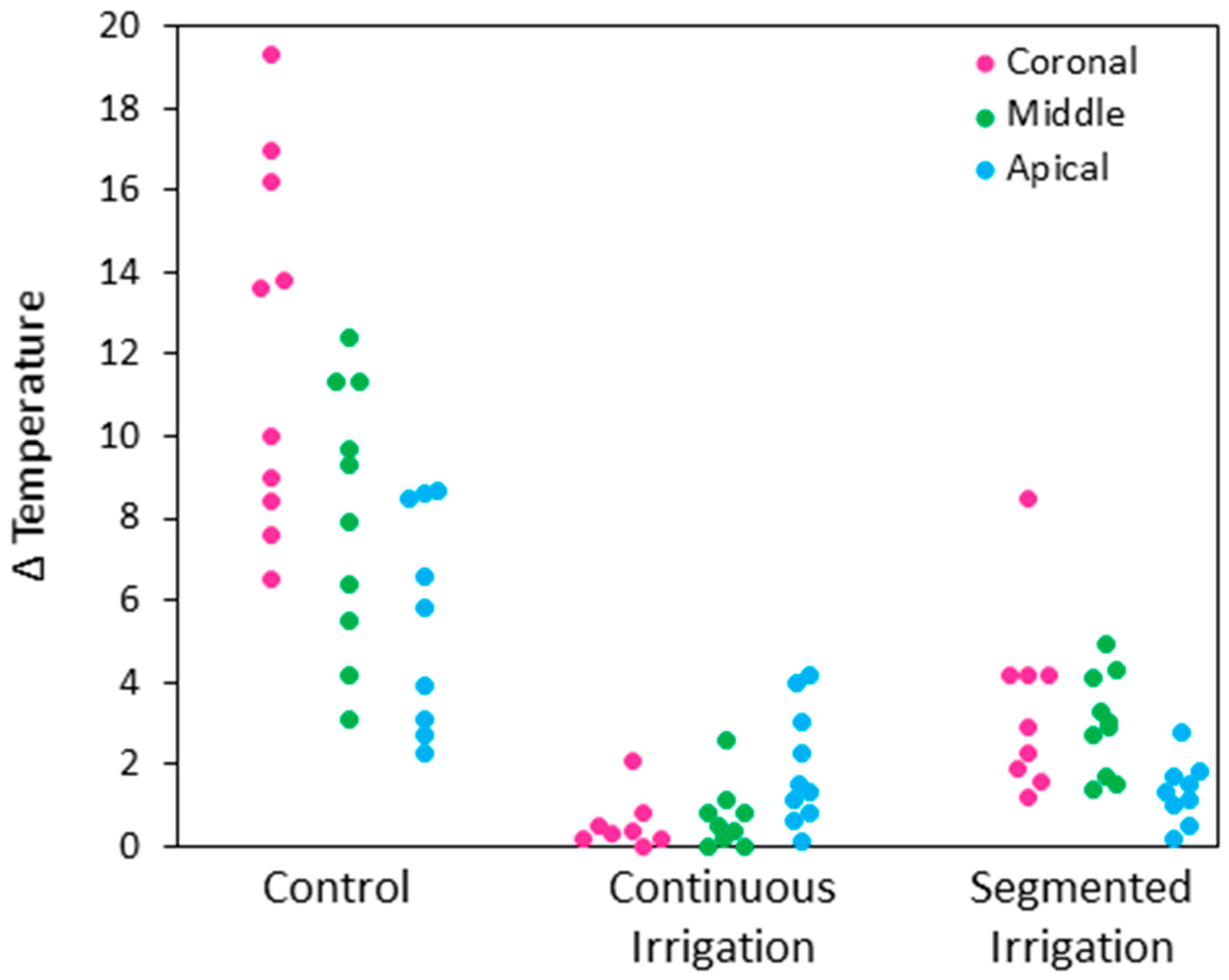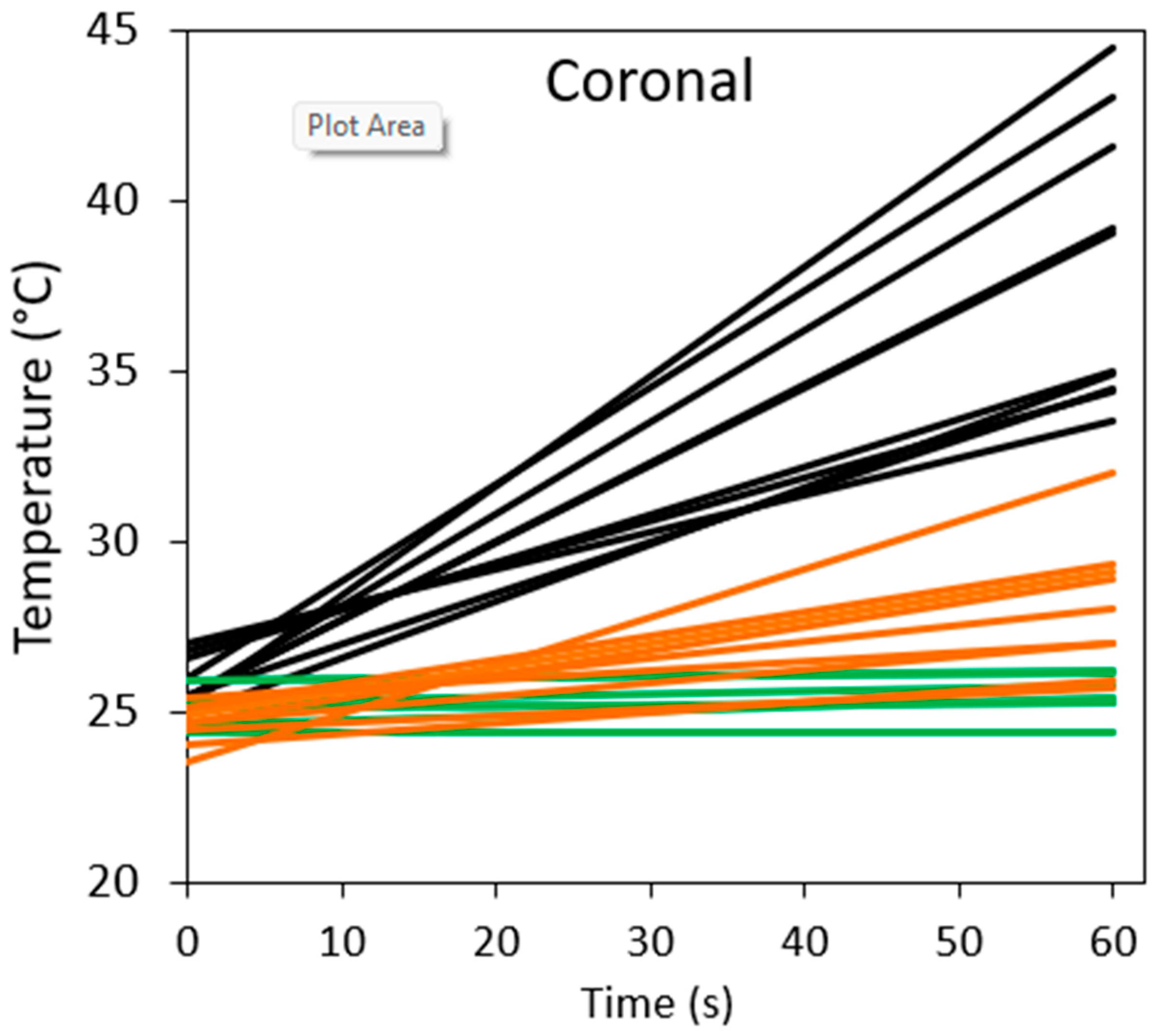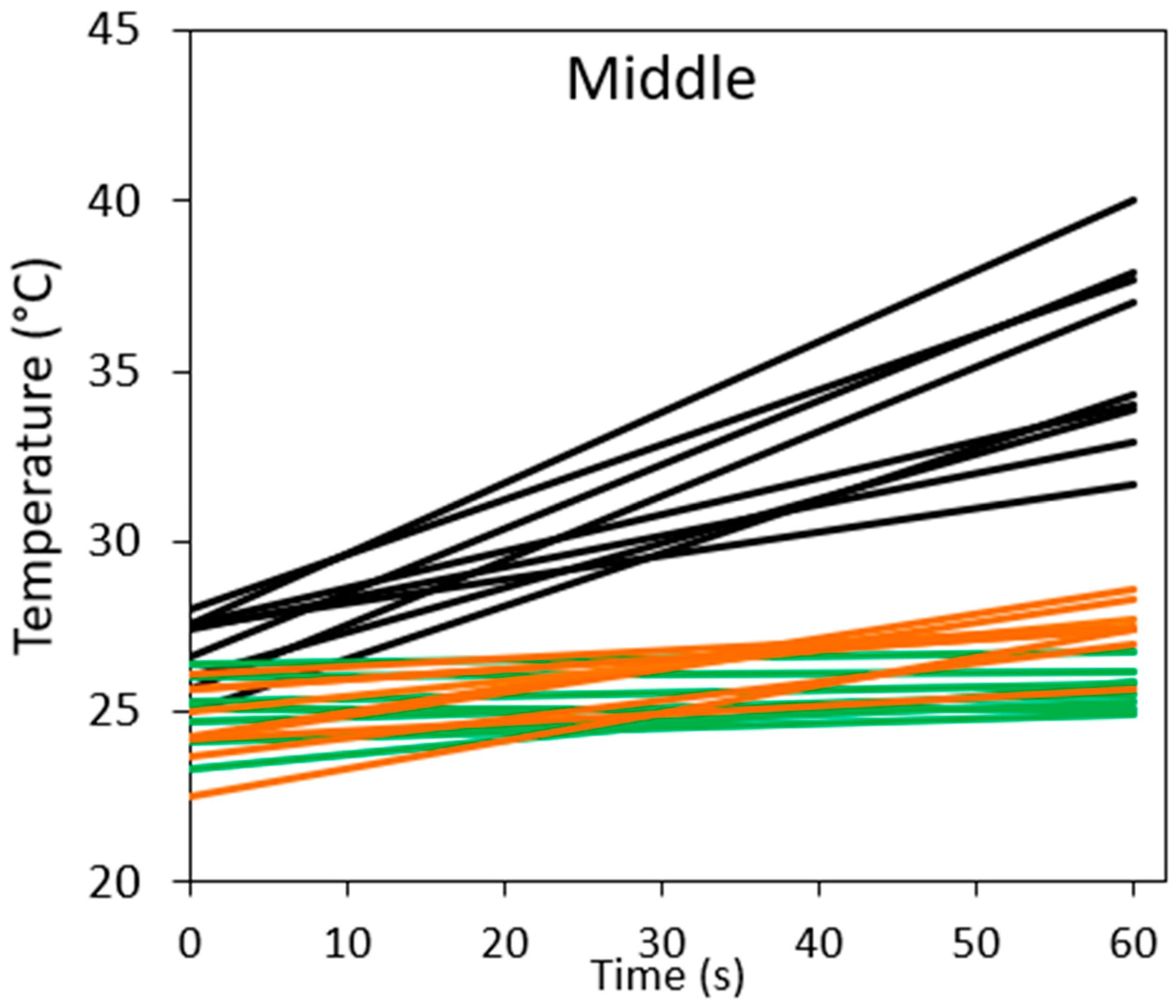Temperature Changes during Er:YAG Laser Activation with the Side-Firing Spiral Endo Tip in Root Canal Treatment
Abstract
:1. Introduction
2. Materials and Methods
2.1. Tooth Preparation
2.2. Laser Specification with the Side-Firing Spiral Tip for Endodontics
2.3. Treatment Groups
2.4. Temperature Measurements
2.5. Statistical Analysis
3. Results
3.1. Comparison of the Temperature Changes during Each Treatment Procedure
3.2. Temperature Changes in the Coronal, Middle and Apical Tooth Sites
4. Discussion
5. Conclusions
Author Contributions
Funding
Institutional Review Board Statement
Informed Consent Statement
Data Availability Statement
Acknowledgments
Conflicts of Interest
References
- Versiani, M.A.; Ordinola-Zapata, R. Root Canal Anatomy: Implications in Biofilm Disinfection. In The Root Canal Biofilm; Chavez de Paz, L., Sedgley, C., Kishen, A., Eds.; Springer: Toronto, ON, Canada, 2015; pp. 155–187. [Google Scholar]
- Torabinejad, M.; Handysides, R.; Khademi, A.A.; Bakland, L.K. Clinical implications of the smear layer in endodontics: A review. Oral Surg. Oral Med. Oral Pathol. 2002, 94, 658–666. [Google Scholar] [CrossRef] [PubMed]
- Hülsmann, M. Effects of mechanical instrumentation and chemical irrigation on the root canal dentin and surrounding tissues. Endod. Top. 2013, 29, 55–86. [Google Scholar] [CrossRef]
- Cunningham, W.T.; Martin, H. A scanning electron microscope evaluation of root canal debridement with the endosonic ultrasonic synergistic system. Oral Surg. Oral Med. Oral Pathol. 1982, 53, 527–531. [Google Scholar] [CrossRef]
- McComb, D.; Smith, D.C. A preliminary scanning electron microscopic study of root canals after endodontic procedures. J. Endod. 1975, 1, 238–242. [Google Scholar] [CrossRef]
- Mader, C.L.; Baumgartner, J.C.; Peters, D.D. Scanning electron microscopic investigation of the smeared layer on root canal walls. J. Endod. 1984, 10, 477–483. [Google Scholar] [CrossRef]
- Aktener, B.O.; Cengiz, T.; Piskin, B. The penetration of smear material into dentinal tubules during instrumentation with surface-active reagents: A scanning electron microscopic study. J. Endod. 1989, 15, 588–590. [Google Scholar] [CrossRef]
- Bra, M.; Nyborg, H. Cavity treatment with a microbicidal fluoride solution: Growth of bacteria and effect on the pulp. J. Prosth. Dent. 1973, 30, 303–310. [Google Scholar]
- Akpata, E.S.; Blechman, H. Bacterial invasion of pulpal dentin wall in vitro. J. Dent. Res. 1982, 61, 435–438. [Google Scholar] [CrossRef]
- Shahravan, A.; Haghdoost, A.A.; Adl, A.; Rahimi, H.; Shadifar, F. Effect of smear layer on sealing ability of canal obturation: A systematic review and meta-analysis. J. Endod. 2007, 33, 96–105. [Google Scholar] [CrossRef]
- Violich, D.R.; Chandler, N.P. The smear layer in endodontics—A review. Int. Endod. J. 2010, 43, 2–15. [Google Scholar] [CrossRef]
- Moodnik, R.M.; Dorn, S.O.; Feldman, M.J.; Levey, M.; Borden, B.G. Efficacy of biomechanical instrumentation: A scanning electron microscopic study. J. Endod. 1976, 2, 261–266. [Google Scholar] [CrossRef] [PubMed]
- Sulewski, J.G. Historical survey of laser dentistry. Dent. Clin. N. Am. 2000, 44, 717–752. [Google Scholar] [CrossRef]
- Kiran, S.; Prakash, S.; Siddharth, P.R.; Saha, S.; Geojan, N.E.; Ramachandran, M. Comparative Evaluation of Smear Layer and Debris on the Canal Walls prepared with a Combination of Hand and Rotary ProTaper Technique using Scanning Electron Microscope. J. Contemp. Dent. Pract. 2016, 17, 574–581. [Google Scholar] [PubMed]
- Ram, Z. Effectiveness of Root Canal Irrigation. Oral Surg. Oral Med. Oral Pathol. 1977, 44, 306–312. [Google Scholar] [CrossRef] [PubMed]
- Raisingani, D.; Meshram, G.K. Cleanliness in the Root Canal System: A Scanning Electron Microscopic Evaluation of Manual and Automated Instrumentation using 4% Sodium Hypochlorite and EDTA (Glyde File Prep)—An in vitro Study. Int. J. Clin. Pediatr. Dent. 2010, 3, 173–182. [Google Scholar] [CrossRef] [PubMed]
- Siqueira, J.F., Jr.; Rôças, I.N. Optimising Single-visit Disinfection with Supplementary Approaches: A Quest for Predictability. Aust. Endod. J. 2011, 37, 92–98. [Google Scholar] [CrossRef] [PubMed]
- Blanken, J.; De Moor, R.J.; Meire, M.; Verdaasdonk, R. Laser induced explosive vapor and cavitation resulting in effective irrigation of the root canal. Part 1: A visualization study. Laser Surg. Med. 2009, 41, 514–519. [Google Scholar] [CrossRef] [PubMed]
- Aranha, A.C.; Domıngues, F.B.; Franco, V.O.; Gutknecht, N.; Eduardo, C.P. Effects of Er:YAG and Nd:YAG lasers on dentin permeability in root surfaces: A preliminary in vitro study. Photomed. Laser Ther. 2005, 23, 504–508. [Google Scholar] [CrossRef]
- Sahar-Helft, S.; Sarp, A.S.; Stabholtz, A.; Gutkin, V.; Redenski, I.; Steinberg, D. Comparison of positive-pressure, passive ultrasonic, and laser-activated irrigations on smear-layer removal from the root canal surface. Photomed. Laser Surg. 2015, 33, 129–135. [Google Scholar] [CrossRef]
- de Groot, S.D.; Verhaagen, B.; Versluis, M.; Wu, M.K.; Wesselink, P.R.; van der Sluis, L.W. Laser-activated irrigation within root canals: Cleaning efficacy and flow visualization. Int. Endod. J. 2009, 42, 1077–1083. [Google Scholar] [CrossRef]
- Eriksson, A.R.; Albrektsson, T. Temperature threshold levels for heat-induced hone tissue injury: A vital microscopic injury: A vital microscope study in the rabbit. J. Prosth. Dent. 1983, 50, 101–107. [Google Scholar] [CrossRef] [PubMed]
- Lan, W.H. Temperature elevation on the root surface during Nd:YAG laser irradiation in the root canal. J. Endod. 1999, 25, 155–156. [Google Scholar] [CrossRef] [PubMed]
- Mazaheri, P. Temperaturentwicklung auf der Wurzeloberfläche bei einer endodonitischen Behandlung mit einem Diodenlaser. Ph.D. Thesis, RWTH Aachen University, Aachen, Germany, 2001. [Google Scholar]
- Gutknecht, N.; Van Gogswaardt, D.; Conrads, G.; Apel, C.; Schubert, C.; Lampert, F. Diode laser radiation and its bactericidal effect in root canal wall dentin. J. Clin. Laser Med. Surg. 2000, 18, 57–60. [Google Scholar] [CrossRef]
- Gutknecht, N. Irradiation of infected root canals with Nd:YAG lasers. A review. LaserZahnheilkunde 2004, 4, 219–226. [Google Scholar]
- Sebbane, N.; Steinberg, D.; Keinan, D.; Vogt Sionov, R.; Farber, A.; Sahar-Helft, S. Antibacterial Effect of Er:YAG Laser Irradiation Applied by a New Side-Firing Spiral Tip on Enterococcus faecalis Biofilm in the Tooth Root Canal—An Ex Vivo Stud. Appl. Sci. 2022, 12, 12656. [Google Scholar] [CrossRef]
- Matsumoto, H.; Yoshimine, Y.; Akamine, A. Visualization of irrigant flow and cavitation induced by Er:YAG laser within a root canal model. J. Endod. 2011, 37, 839–843. [Google Scholar] [CrossRef]
- Gregorcic, P.; Jamsek, M.; Lukač, M.; Jezersek, M. Synchronized delivery of Er:YAG laser-pulse energy during oscillations of vapor bubbles. J. Laser Health Acad. 2014, 1, 6. [Google Scholar]
- De Moor, R.J.; Blanken, J.; Meire, M.; Verdaasdonk, R. Laser induced explosive vapor and cavitation resulting in effective irrigation of the root canal. Part 2: Evaluation of the efficacy. Lasers Surg. Med. 2009, 41, 520–523. [Google Scholar] [CrossRef]
- Zehnder, M. Root canal irrigants. J. Endod. 2006, 32, 389–398. [Google Scholar] [CrossRef]
- Fraser, J.G. Chelating agents: Their softening effect on root canal dentin. Oral Surg. Oral Med. Oral Pathol. 1974, 37, 803–811. [Google Scholar] [CrossRef]
- Bahcall, J.; Howard, P.; Miserendino, L.; Walia, H. Preliminary investigation of the histological effects of laser endodontic treatment on the periradicular tissues in dogs. J. Endod. 1992, 18, 47–51. [Google Scholar] [CrossRef]
- Kimura, Y.; Yonaga, K.; Yokoyama, K.; Kinoshita, J.; Ogata, Y.; Matsumoto, K. Root surface temperature increase during Er:YAG laser irradiation of root canals. J. Endod. 2002, 28, 76–78. [Google Scholar] [CrossRef] [PubMed]
- Jacobsen, T.; Norlund, A.; Englund, G.S.; Tranaeus, S. Application of laser technology for removal of caries: A systematic review of controlled clinical trials. Acta. Odont. Scandinav. 2011, 69, 65–74. [Google Scholar] [CrossRef] [PubMed]
- Rohde, M.; Mehari, F.; Klämpfl, F.; Adler, W. The differentiation of oral soft and hard tissues using laser induced breakdown spectroscopy—A prospect for tissue specific laser surgery. J. Biophotonics 2017, 10, 1250–1261. [Google Scholar] [CrossRef] [PubMed]






| Group | Compared to | Mean Difference | SE | t | PTukey |
|---|---|---|---|---|---|
| Continued Irrigation | Control | 7.794 | 0.652 | −11.948 | <0.001 |
| Continued Irrigation | Segmented Irrigation | 1.526 | 0.664 | −2.300 | 0.062 |
| Control | Segmented Irrigation | 6.268 | 0.645 | 9.715 | <0.001 |
| Group | Compared to | Mean Difference | SE | t | PTukey |
|---|---|---|---|---|---|
| Apical | Coronal | −2.210 | 0.658 | −3.359 | <0.003 |
| Apical | Middle | −0.762 | 0.645 | −1.181 | 0.468 |
| Coronal | Middle | 1.449 | 0.658 | 2.202 | 0.077 |
| Method | Surface Site | Compared to Method | Surface Site | Mean Difference | SE | t | PTukey |
|---|---|---|---|---|---|---|---|
| Continued | Apical | Control | Apical | −4.406 | 1.097 | −4.015 | 0.004 |
| Segmented | Apical | 0.572 | 1.127 | 0.507 | 1.000 | ||
| Continued | Coronal | 1.331 | 1.164 | 1.144 | 0.965 | ||
| Control | Coronal | −10.246 | 1.097 | −9.337 | <0.001 | ||
| Segmented | Coronal | −1.550 | 1.127 | −1.375 | 0.904 | ||
| Continued | Middle | 1.183 | 1.127 | 1.049 | 0.979 | ||
| Control | Middle | −6.216 | 1.097 | −5.665 | <0.001 | ||
| Segmented | Middle | −1.086 | 1.097 | −0.990 | 0.985 | ||
| Control | Apical | Segmented | Apical | 4.978 | 1.127 | 4.415 | 0.001 |
| Continued | Coronal | 5.737 | 1.164 | 4.930 | <0.001 | ||
| Control | Coronal | −5.840 | 1.097 | −5.322 | <0.001 | ||
| Segmented | Coronal | 2.856 | 1.127 | 2.533 | 0.233 | ||
| Continued | Middle | 5.589 | 1.127 | 4.957 | <0.00 | ||
| Control | Middle | −1.810 | 1.097 | −1.649 | 0.774 | ||
| Segmented | Middle | 3.320 | 1.097 | 3.026 | 0.077 | ||
| Segmented | Apical | Continued | Coronal | 0.760 | 1.192 | 0.637 | 0.999 |
| Control | Coronal | −10.818 | 1.127 | −9.595 | <0.001 | ||
| Segmented | Coronal | −2.122 | 1.157 | −1.835 | 0.659 | ||
| Continued | Middle | 0.611 | 1.157 | 0.528 | 1.000 | ||
| Control | Middle | −6.788 | 1.127 | −6.021 | <0.001 | ||
| Segmented | Middle | −1.658 | 1.127 | −1.470 | 0.865 | ||
| Continued | Coronal | Control | Coronal | −11.577 | 1.164 | −9.947 | <0.001 |
| Segmented | Coronal | −2.882 | 1.192 | −2.417 | 0.290 | ||
| Continued | Middle | −0.149 | 1.192 | −0.125 | 1.000 | ||
| Control | Middle | −7.547 | 1.164 | −6.485 | <0.001 | ||
| Segmented | Middle | −2.417 | 1.164 | −2.077 | 0.496 | ||
| Control | Coronal | Segmented | Coronal | 8.696 | 1.127 | 7.713 | <0.001 |
| Continued | Middle | 11.429 | 1.127 | 10.138 | <0.001 | ||
| Control | Middle | 4.030 | 1.097 | 3.673 | 0.013 | ||
| Segmented | Middle | 9.160 | 1.097 | 8.348 | <0.001 | ||
| Segmented | Coronal | Continued | Middle | 2.733 | 1.157 | 2.363 | 0.319 |
| Control | Middle | −4.666 | 1.127 | −4.138 | 0.003 | ||
| Segmented | Middle | 0.464 | 1.127 | 0.412 | 1.000 | ||
| Continued | Middle | Control | Middle | −7.399 | 1.127 | −6.563 | <0.001 |
| Segmented | Middle | −2.269 | 1.127 | −2.013 | 0.540 | ||
| Control | Middle | Segmented | Middle | 5.130 | 1.097 | 4.675 | <0.001 |
Disclaimer/Publisher’s Note: The statements, opinions and data contained in all publications are solely those of the individual author(s) and contributor(s) and not of MDPI and/or the editor(s). MDPI and/or the editor(s) disclaim responsibility for any injury to people or property resulting from any ideas, methods, instructions or products referred to in the content. |
© 2023 by the authors. Licensee MDPI, Basel, Switzerland. This article is an open access article distributed under the terms and conditions of the Creative Commons Attribution (CC BY) license (https://creativecommons.org/licenses/by/4.0/).
Share and Cite
Sahar-Helft, S.; Sebbane, N.; Farber, A.; Sionov, R.V.; Dakar, R.; Steinberg, D. Temperature Changes during Er:YAG Laser Activation with the Side-Firing Spiral Endo Tip in Root Canal Treatment. Photonics 2023, 10, 488. https://doi.org/10.3390/photonics10050488
Sahar-Helft S, Sebbane N, Farber A, Sionov RV, Dakar R, Steinberg D. Temperature Changes during Er:YAG Laser Activation with the Side-Firing Spiral Endo Tip in Root Canal Treatment. Photonics. 2023; 10(5):488. https://doi.org/10.3390/photonics10050488
Chicago/Turabian StyleSahar-Helft, Sharonit, Nathanyel Sebbane, Adi Farber, Ronit Vogt Sionov, Roni Dakar, and Doron Steinberg. 2023. "Temperature Changes during Er:YAG Laser Activation with the Side-Firing Spiral Endo Tip in Root Canal Treatment" Photonics 10, no. 5: 488. https://doi.org/10.3390/photonics10050488
APA StyleSahar-Helft, S., Sebbane, N., Farber, A., Sionov, R. V., Dakar, R., & Steinberg, D. (2023). Temperature Changes during Er:YAG Laser Activation with the Side-Firing Spiral Endo Tip in Root Canal Treatment. Photonics, 10(5), 488. https://doi.org/10.3390/photonics10050488





